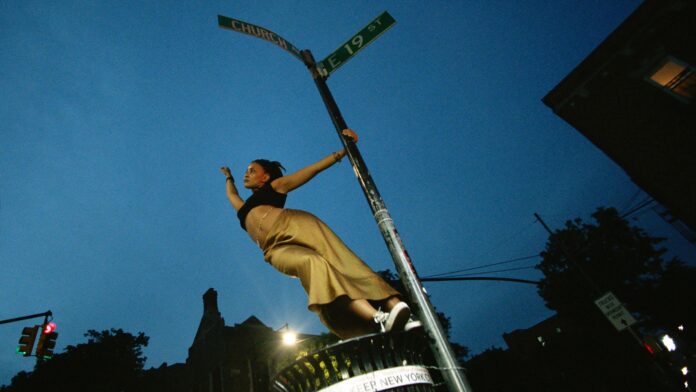Brooklyn was never New York. Not really. It’s a dirty mirror, a crumpled promise at the bottom of a city’s pocket, a city that no longer believes in itself. But in Tendaberry—the film that premiered at Sundance in 2024 and recently landed on MUBI—director Haley Elizabeth Anderson dares the impossible: not to depict Brooklyn, but to breathe it. And she pulls it off. With sleight of hand, with tenderness, with a blade that cuts before you know it. That’s what makes the film dangerous—and necessary.
The film has no plot. Or it does, but it doesn’t matter. A Dominican girl, Dakota, lives in South Brooklyn with her Ukrainian boyfriend. He leaves. She stays. He disappears. She survives. Nothing happens. What happens is time. What happens is the city—like a dirty tide that never fully recedes. What happens is the gaze.
Because Tendaberry doesn’t want to tell a story. It wants to inhabit. In that gesture—one that looks minimal, but is deeply political—the film reminds us of something cinema often forgets: that stories lie not in what happens, but in what remains.
It’s not a film about migration, but everything in it is leaving. It’s not about grief, but it hurts. It’s not about youth, but it’s full of exhaustion. It’s a film in transit, with no destination. As if Cassavetes had grown up in a Dominican hair salon in Flatbush, watching Nelson Sullivan videos and listening to soft reggaetón, with a copy of Trinh T. Minh-ha tucked in his backpack. It sounds impossible, and yet it works.
Visually, the film is shamelessly anachronistic. Super 8, 4K, VHS archive, grainy textures, off-kilter framing. There’s no technical coherence. There’s style. Or rather: there’s an ethics of looking. Anderson—filmmaker, writer, and artist from Texas, trained at NYU’s film school—doesn’t shoot Brooklyn as a location. She films it as archive. As a story that repeats and erases itself at the same time. As a space where nothing is new, but everything feels urgent. That’s urban anthropology with a handheld camera and no need for permission.
Dakota, played with magnetic opacity by Kota Johan, is never explained. She doesn’t cry to make the viewer understand. She doesn’t fall apart on screen to give the film emotional weight. She just goes on. She works. She waits. She dances. She watches. That refusal to spectacularize the lives of the poor, the migrant, the racialized, makes Tendaberry an ethical anomaly. Not because there’s no suffering, but because there’s no suffering porn. In the toxic ecosystem of American indie film, that’s almost an act of aesthetic violence.

Queerness appears as it should: without label. It’s a way of looking, of being, of desiring without naming. The Nelson Sullivan archive—a kind of VHS-era Walter Benjamin—isn’t there for decoration or to say “this is history.” It’s there the way everything in this film is there: as fragment, as residue, as something that comes back because it never really left. Tendaberry doesn’t want to update nostalgia. It wants to disable it. The city wasn’t better before. It was just different. Just as cruel, just as beautiful, just as absurd.
There’s beauty in this film. But not the clean beauty of Brooklyn postcards for French tourists, or the dirty beauty of aestheticized poverty. There’s something else. Something closer to a way of enduring. A kind of aesthetics of insistence. It’s not that Dakota has hope. It’s that she has no other choice.
Tendaberry could be read as a visual ethnography of emotional precarity under late capitalism. But that would be a flattening. The film doesn’t analyze. It exudes. Gentrification isn’t a theme—it’s a climate. Racialization isn’t discussed—it’s embodied. The war in Ukraine isn’t explained—it interrupts. Like calls that never come, texts that go unread, lives unraveling just outside the frame.
The music, scattered and understated, is another strength. There’s no score guiding emotion. What there is, is noise. Street sounds, stray phrases, poorly recorded songs. As if the world were always slightly off-beat. As if synchronization were a class privilege.
Tendaberry is brutal in its subtlety. It doesn’t shout—but by the time you notice, you’re already inside. Because there’s no catharsis. There’s something worse: recognition. You’ve been there. You’ve seen that. You were Dakota. Or you saw her. Or ignored her. And the film doesn’t forgive.
But it doesn’t accuse either. And that’s what saves it from easy cynicism. Anderson doesn’t want to teach. She wants to unsettle—and she does it with intelligence, with dry humor, with a tenderness you don’t feel until it’s too late. The film is political, yes, but in the way a family recipe is political. Or gossip between friends. Or a makeshift party with Christmas lights and warm beer. The intimate as battleground.
There’s no ending, just a kind of fading out. As if the film itself were tired of being alive. As if it knew it couldn’t promise anything. And even in that gesture, there’s something. Something small, that seems to say: we go on. Not because we want to. Not because we can. But because there’s no other option. And sometimes, that’s enough.
Tendaberry isn’t a perfect film. It’s a wise one. And these days, that’s much rarer.
